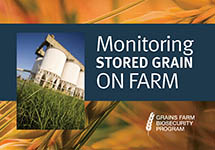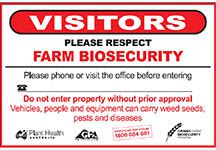 Grain Producers Australia represents the biosecurity interests of grain producers and the industry. They are members of Plant Health Australia and signatories to the Emergency Plant Pest Response Deed. Their responsibilities include:
Grain Producers Australia represents the biosecurity interests of grain producers and the industry. They are members of Plant Health Australia and signatories to the Emergency Plant Pest Response Deed. Their responsibilities include:
- biosecurity planning and implementation at the national and farm levels
- liaising with federal and state governments on trade issues
- funding and supporting biosecurity initiatives
- participating in national committees and response efforts in an emergency.
Industry overview
Most of Australia’s grain is produced across the region known as the wheat belt, which stretches from central Queensland through New South Wales, Victoria, Tasmania, South Australia and southern Western Australia. Due to the wide-ranging soil types and climatic variability across Australia, a range of crop species and varieties are grown, each of which has specific pests and diseases that pose a threat to production and can influence access to markets (both domestic and overseas).
Grains Farm Biosecurity Program
Expand

Grains Biosecurity Officers are located in most states through the Grains Farm Biosecurity Program. The program is delivered by Plant Health Australia and funded by growers via Grain Producers Australia together with the Western Australian, Queensland, Victorian, South Australian and New South Wales state governments. More
Surveillance
Expand
 National Grain Biosecurity Surveillance Strategy
National Grain Biosecurity Surveillance Strategy
The National Grain Biosecurity Surveillance Strategy 2019-29 was developed in conjunction with industry to ensure it is effective and robust, yet flexible enough to adapt to emerging technologies and industry structures outside that of government, and is underpinned by core biosecurity capacity.
The strategy will guide the implementation of national leadership, management and coordination of surveillance activities for high priority grain pests and pests of market access concern for the grain industry.
Specific actions and tasks are listed that will improve pre-border and border pest risk and pathway assessment by better understanding pest risk profiles and pathways and targeting surveillance efforts. For post-border surveillance, it describes an enhanced partnership approach between Grain Producers Australia, Plant Health Australia, the Grains Research and Development Corporation, Grain Growers Ltd, bulk handlers, traders and Australian governments through a national surveillance program. This program is supported by enhanced diagnostic networks, practical training and reporting services to enable surveillance efforts to be captured, monitored and improved.
Biosecurity plan, manuals and sign
Expand
 Industry Biosecurity Plan for the Grains Industry
Industry Biosecurity Plan for the Grains Industry
Biosecurity planning provides a mechanism for the grains industry, government and other relevant stakeholders to assess current biosecurity practices and future biosecurity needs. Planning identifies procedures that can be put in place to reduce the chance of pests reaching our borders or minimise the impact if a pest incursion occurs.
The Industry Biosecurity Plan for the Grains Industry provides a framework for biosecurity risk mitigation measures in the industry. For a copy, please contact PHA on 02 6215 7700 or email biosecurity@phau.com.au
 Biosecurity manuals for grain producers
Biosecurity manuals for grain producers
The Biosecurity Manual for Grain Producers contains information to help producers to implement biosecurity on-farm. Manuals usually contain an overview of biosecurity, fact sheets to identify the high priority pests of a crop, tips on crop management, and how to manage people, vehicles and equipment to minimise biosecurity risks. Manuals also contain a biosecurity self-assessment list, and templates to record pest surveillance records and visitors.
More information about on-farm biosecurity for both plant and livestock producers is available from the Farm Biosecurity website.
 The Farm Biosecurity Manual for the Organic Grains Industry contains biosecurity information specifically for growers of organic grains.
The Farm Biosecurity Manual for the Organic Grains Industry contains biosecurity information specifically for growers of organic grains.
 |
Fall Armyworm Continuity Plan for the Australian Grains Industry
The Fall Armyworm Continuity Plan was developed for use by professionals, specialists and consultants to prepare localised and industry specific communication and extension material. The plan focuses on the grain industry and provides:
The purpose of the plan is to provide a reference point and a basis for industry to build upon when designing resistance management strategies, area wide management plans, crop-specific management manuals, and other extension materials such as audio and visual products for the management of FAW within Australian broadacre farming systems. |
 |
With zero market tolerance for live pests in grain, storage is no time to forget about biosecurity. Working closely with grains storage specialists, the Monitoring stored grain on farm manual pulls together information from a number of other resources, complementing those already produced by the GRDC Grains Storage Projects. |
 |
Signs can be used to indicate to visitors the importance of following biosecurity procedures on your property. This template can be downloaded and used to print a 900 x 600 mm gate sign. Remember to include contact details in the space provided. For signage to be effective:
|
Fact sheets
Expand
The grains industry and PHA have created some fact sheets to increase biosecurity awareness.
Pollination information
Expand
Fact sheets and web links about pollination of grain crops are listed below. Please be aware that some of the information was developed overseas, and environmental and seasonal variations may occur.
The Pollination Program (AgriFutures Australia and Hort Innovation)
Sunflower pollination fact sheet
Faba beans pollination fact sheet
Soybean pollination fact sheet
NSW Department of Primary Industries
Honey bees in faba bean pollination
Others
Growing faba beans, Victorian Department of Environment and Primary Industries
Bees on canola: what are the benefits, Manitoba Department of Agriculture, Food and Rural Development, Canada
Bees and canola: a sweet relationship, Canola Council of Canada
Pests Expand
Exotic pests (not in Australia)
The following is a list of high priority exotic pests of grains and pulses. These pests were identified during the development of the Industry Biosecurity Plan for the Grains Industry in consultation with industry, government and scientists. They have been assessed as high priority pests based on their potential to enter, establish, and spread in Australia (eg environmental factors, host range, vectors) and the cost to industry of control measures.
PHA has a range of fact sheets, contingency plans and diagnostic protocols relevant to these pests. Pest risk review documents are also available for some pests. Please contact PHA on 02 6215 7700 or email biosecurity@phau.com.au for more information.
Endorsed National Diagnostic Protocols are available from the National Plant Biosecurity Diagnostic Network webpage.
| Common name | Scientific name | EPPRD Category | Fact sheet | Contingency plan | Diagnostic protocol |
|---|---|---|---|---|---|
| Banded leaf and sheath spot of maize | Rhizoctonia solani f. sp. sasakii | CP | |||
| Barley stem gall midge | Mayetiola hordei | FS | CP | ||
| Barley stripe rust | Puccinia striiformis f. sp. hordei | FS | CP | DP | |
| Bruchids | Multiple species in the Acanthoscelides, Bruchus, Bruchidius, Callosobruchus, Caryedon and Zabrotes genera | FS | |||
| Cabbage seedpod weevil | Ceutorhynchus obstrictus | FS | CP | ||
| Cabbage stem weevil | Ceutorhynchus pallidactylus | FS | |||
| Cereal cyst nematode | Heterodera filipjevi (exotic strains) | CP | |||
| Cereal cyst nematode | Heterodera latipons (exotic strains) | CP | |||
| Chickpea chlorotic dwarf virus | Chickpea chlorotic dwarf virus (Geminivirus) | CP | |||
| Chickpea chlorotic stunt virus | Chickpea chlorotic stunt virus (Polerovirus) | CP | |||
| Chickpea cyst nematode | Heterodera ciceri | CP | |||
| Downy mildew of sorghum | Peronosclerospora sorghi | FS | CP | ||
| Downy mildew of sunflower | Plasmopara halstedii | FS | CP | ||
| European wheat stem sawfly | Cephus pygmeus | FS | CP CP | ||
| False codling moth | Thaumatotibia leucotreta syn Cryptophlebia leucotreta | 2 | FS | CP | |
| Fusarium wilt of chickpea | Fusarium oxysporum f. sp. ciceris | FS | CP | DP | |
| Fusarium wilt of lupin | Fusarium oxysporum f. sp. lupini | CP | |||
| Greenbug | Schizaphis graminum | FS | CP | ||
| Hessian fly | Mayetiola destructor | 3 | FS | CP | DP |
| Karnal bunt | Tilletia indica | 2 | FS | CP | DP |
| Khapra beetle | Trogoderma granarium | 2 | FS FS | CP | DP |
| Late wilt of maize | Harpophora maydis | CP | |||
| Lentil anthracnose | Colletotrichum truncatum (lentil strain) | FS | CP | DP | |
| Mungbean yellow mosaic virus | Mungbean yellow mosaic virus (Begomovirus) | FS | |||
| Northern corn rootworm | Diabrotica barberi | FS | |||
| Peanut stripe virus | Peanut stripe virus (Potyvirus) | CP | |||
| Philippine downy mildew of maize | Peronosclerospora philippinensis | CP | |||
| Rape stem weevil | Ceutorhynchus napi | FS | |||
| Southern corn rootworm | Diabrotica undecimpunctata | FS | |||
| Soybean cyst nematode | Heterodera glycines | FS | CP | ||
| Spotted stem borer | Chilo partellus | CP | |||
| Stem rust of wheat | Puccinia graminis f. sp. tritici (pathotype Ug99) | FS | CP | ||
| Stewarts wilt of maize | Pantoea stewartii subsp. stewartii | FS | |||
| Sudden death syndrome of soybean | Multiple species including: Fusarium virguliforme, F. brasiliense, F. cuneirostrum and F. tucumaniae | FS | |||
| Sunflower moth | Homoeosoma electellum | FS | |||
| Sunflower stem canker | Phomopsis helianthi | DP | |||
| Sunflower stem weevil | Cylindrocopturus adspersus | FS | |||
| Sunn pest | Eurogaster integriceps | FS | CP | ||
| Western corn rootworm | Diabrotica virgifera | FS | |||
| Wheat bug | Nysius huttoni | CP | |||
| Wheat stem sawfly | Cephus cinctus | FS | CP |
Other pests
The following is a list of documents for other exotic and endemic pests of grains and pulses. Please note that this is not a complete list of pests: rather it includes pests for which documents exist in the Pest Information Document Database.
Some of the documents presented here are not tailored to grains and pulses and are included for information only.
| Common name | Scientific name | EPPRD Category | Fact sheet | Contingency plan | Diagnostic protocol |
|---|---|---|---|---|---|
| American serpentine leaf miner | Liriomyza trifolii | FS FS FS | CP | ||
| Bacterial leaf streak | Xanthomonas translucens pv. translucens | CP | |||
| Bacterial leaf streak | Xanthomonas translucens pv. undulosa | CP | |||
| Bakanae | Gibberella fujikuroi | CP | |||
| Barley mild mosaic virus | Barley mild mosaic virus (Baymovirus) | FS | |||
| Barley miner fly | Agromyza megalopsis | CP | |||
| Barley stem rust | Puccinia graminis f. sp. hordei (exotic strains) | ||||
| Barley stripe mosaic virus | Barley stripe mosaic virus (Hordeivirus) | CP | |||
| Bean weevil | Acanthoscelides argillaceus | FS | |||
| Black wheat leaf miner | Agromyza albipennis | FS | |||
| Branched broomrape | Orobanche ramosa | FS | |||
| Brassica pod midge | Dasineura brassicae | CP | |||
| Broad bean mottle virus | Broad bean mottle virus (Bromovirus) | ||||
| Broad bean stain virus | Broad bean stain virus (Comovirus) | ||||
| Broad bean true mosaic virus | Broad bean true mosaic virus (Comovirus) | ||||
| Bruchids | Multiple species in the Acanthoscelides, Bruchus, Bruchidius, Callosobruchus, Caryedon and Zabrotes genera | FS | |||
| Cabbage leaf miner | Phytomyza rufipes | FS | |||
| Cassava spider mite | Tetranychus truncatus | FS | |||
| Cereal cyst nematode | Heterodera avenae (exotic strains) | CP | |||
| Cereal leaf miner | Agromyza ambigua | CP | |||
| Chickpea leaf miner | Liriomyza cicerina | CP | |||
| Chinch bug | Blissus leucopterus | FS | |||
| Crown rust of barley | Puccinia coronata f. sp. hordei | ||||
| Durum leaf rust | Puccinia reconditia (exotic strains) | ||||
| Dwarf bunt of wheat | Tilletia controversa | CP | |||
| Fusarium wilt of canola | Fusarium oxysporum f. sp. conglutinans | FS | CP | ||
| Fusarium wilt of lentil | Fusarium oxysporum f. sp. lentis | CP | |||
| Goss’s bacterial wilt blight of corn | Clavibacter michiganensis subsp. nebraskensis | ||||
| Greenhouse whitefly | Trialeurodes vaporariorum | FS | |||
| Spongy moths | Lymantria dispar and Lymantria mathura | FS FS FS | CP | ||
| Indian green jassid | Amrasca devastans | FS FS | |||
| Japanese beetle | Popillia japonica | FS | |||
| Leaf blight of wheat | Alternaria triticina | CP | |||
| Leaf blotch of cereals | Bipolaris spicifera | CP | |||
| Leaf miners | Multiple species in the Agromyza, Cerodontha, Chromatomyia, Liriomyza, Phytomyza and Pseudonapomyza genera | FS FS FS FS FS FS | CP CP CP | ||
| Leaf rust | Puccinia triticina (exotic strains) | ||||
| Leaf spot of field pea | Alternaria humicola | CP | |||
| Lentil rust | Uromyces viciae-fabae (lentil strain) | FS | CP | ||
| Lupin rust | Uromyces lupinicola | FS | |||
| Lupin rust | Uromyces renovatus | FS | |||
| Maize cyst nematode | Heterodera zeae | CP | |||
| Maize dwarf mosaic virus | Maize dwarf mosaic virus (Potyvirus) | CP | |||
| May beetle | Phyllophaga spp. | CP | |||
| Mediterranean pulse beetle | Bruchus emarginatus | FS | |||
| Melon thrips | Thrips palmi | FS | |||
| Mexican bean weevil | Zabrotes subfasciatus | FS | |||
| Net form of net blotch | Pyrenophora teres f. sp. teres | CP | |||
| Oat leaf miner fly | Chromatomyia fusicula | CP | |||
| Pacific spider mite | Tetranychus pacificus | FS | |||
| Pea early browning virus | Pea early browning virus (Tobravirus) | ||||
| Pea enation mosaic virus | Pea enation mosaic virus (Enamovirus) | ||||
| Pea leaf miner | Chromatomyia horticola | FS | CP | ||
| Pea leaf weevil | Sitona lineatus | CP | |||
| Red clover vein mosaic virus | Red clover vein mosaic virus (Carlavirus) | CP | |||
| Russian wheat aphid | Diuraphis noxia | 3 | FS | CP | |
| Rust of field pea | Uromyces pisi (field pea strain) | FS | CP | ||
| Serpentine leaf miner | Liriomyza huidobrensis | FS FS FS FS | CP | ||
| Soil borne viruses of wheat | |||||
| Sorghum shoot fly | Atherigona soccata | CP | |||
| Stem nematode | Ditylenchus dipsaci | FS | |||
| Sudden death syndrome of soybean | Multiple species including: Fusarium virguliforme, F. brasiliense, F. cuneirostrum and F. tucumaniae | FS | |||
| Tarnished plant bug | Lygus lineolaris | FS FS FS | CP | ||
| Tomato leaf miner (Liriomyza bryoniae) | Liriomyza bryoniae | FS | CP CP | ||
| Vegetable leaf miner | Liriomyza sativae | 3 | FS FS FS FS FS FS | CP | |
| Verticillium wilt of canola | Verticillium longisporum | CP | |||
| Western plant bug | Lygus hesperus | FS | |||
| Wheat aphid | Sitobion avenae | CP | |||
| Wheat blast | Magnaporthe grisea (Triticum pathotype) | FS | |||
| Wheat leaf miner | Chromatomyia nigra | CP | |||
| Wheat sheath leaf miner | Cerodontha denticornis | CP | |||
| Wheat spindle streak mosaic virus | Wheat spindle streak mosaic virus (Bymovirus) | 4 | |||
| Wheat stem maggot | Meromyza americana | CP | |||
| Wheat stem maggot | Meromyza saltatrix | CP | |||
| Wheat stripe rust | Puccinia striiformis f. sp. tritici (exotic strains) | ||||
| Witchweed | Striga asiatica and Striga hermonthica | FS |











Recent Comments